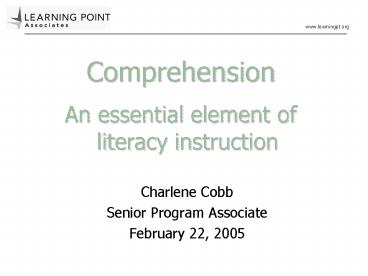Comprehension - PowerPoint PPT Presentation
1 / 18
Title:
Comprehension
Description:
Are unable to tell us what the passages meant. Don't know when they are not comprehending. ... Definition: Reading is a meaning-making activity ... – PowerPoint PPT presentation
Number of Views:45
Avg rating:3.0/5.0
Title: Comprehension
1
Comprehension
An essential element of literacy instruction
- Charlene Cobb
- Senior Program Associate
- February 22, 2005
2
Five Essential Elements of Reading
- Identified by the National Reading Panel as
critical components to reading success - Phonemic awareness
- Phonics
- Vocabulary
- Fluency
- Comprehension
3
Vocabulary
- Vocabulary development is linked to levels of
comprehension. - Students have speaking, listening, reading, and
writing vocabularies These will vary in depth
and breadth. - Teaching vocabulary should be done both directly
and indirectly. - Repetition and multiple exposures to words is
critical.
4
Fluency
- Fluency is the ability to read with speed,
accuracy, and proper expression. - Fluency is a critical factor in reading
comprehension. - Disfluent readers labor through text and have
difficulty remembering what was read. - Reading practice is an important contributor to
fluency.
5
Profile of Many Readers
- After reading they...
- Are unable to tell us what the passages meant.
- Dont know when they are not comprehending.
- Dont know when they are comprehending.
- Dont know they are supposed to comprehend when
they read. - Dont seem to know that text is supposed to mean
something.
6
Skills vs. Strategies
- Skills
- Automatic
- Overlearning
- Immediate
- Simple or single step
- Certainty of success
- Accuracy
- Strategies
- Intentional
- Metacognitive control
- Reflective
- Complex or multistep
- Probability of success
- Approximation
To be successful, students need to develop skills
and strategies.
7
Comprehension Instruction Prior to 1960
- Underlying Skills Approach
- Definition Reading is high-speed word
recognition - Assumptions Comprehension problems are due to
weaknesses in underlying processes or abilities.
Any message that can be understood by ear, can be
understood by eye. - Teaching approach Comprehension instruction is
unnecessary, so teaching emphasizes underlying
abilities, including phonics, vocabulary,
fluency, knowledge.
8
Comprehension Instruction Prior to 1980
- Assignment method
- Definition Reading is understanding
- Assumptions Comprehension problems arise from
lack of practice, or because children ignore
meaning. - Teaching approach Comprehension exercises,
written or oral, are assigned. Students read and
show that they understand what they have read.
Assignments may highlight particular types of
information, but provide no direction in how to
find or use such information.
9
Comprehension Instruction 2004
- Strategy teaching
- Definition Reading is a meaning-making activity
- Assumptions Comprehension can be improved if
readers intentionally process text in particular
ways. - Teaching approach Within the context of reading
practice, students receive specific guidance in
how to understand a text.
10
What We know about strategies
- There are only a handful of thinking strategies
used consistently by proficient readers. - They are common to proficient readers of many
ages. - They are used in silent and oral reading and when
listening to text. - These processes or cognitive strategies can be
taught systematically. - The certain methods and models are most effective
in teaching comprehension.
11
Cognitive Strategies
- Activating relevant, prior knowledge (schema)
before, during, and after reading text. - Proficient readers use prior knowledge to
evaluate the adequacy of the model of meaning
they have developed and to store newly learned
information with other related memories.
Text-to-text, text-to-self, text-to-world, and
new connections. - Determining the most important ideas and themes
in a text. - Proficient readers use their conclusions about
important ideas to focus their reading and to
exclude peripheral or unimportant details from
memory.
12
Cognitive Strategies (Continued)
- Asking questions of themselves, the authors, and
the texts they read. - Proficient readers use their questions to
clarify and focus their reading. - Creating visual and other sensory images from
text during and after reading. - Proficient readers use these images to deepen
their understanding of the text. These images may
include visual, auditory, and other sensory
connections to the text.
13
Cognitive Strategies (Continued)
- Drawing inferences from text.
- Proficient readers use the prior knowledge
(schema) and textual information to draw
conclusions, make critical judgments, and form
unique interpretations from text. Inferences may
occur in the form of conclusions, predictions, or
new ideas. - Retelling or synthesizing what they have read.
- Proficient readers attend to the most important
information and to the clarity of the synthesis
itself. Readers synthesize in order to better
understand what they have read.
14
Cognitive Strategies (Continued)
- Utilizing a variety of fix-up strategies to
repair comprehension when it breaks down. - Proficient readers select appropriate fix-up
strategies from one of the six language systems
(pragmatic, schematic, semantic, syntactic,
lexical, or grapho-phonic) to best solve a given
problem in a given reading situation (i.e., skip
ahead, or reread, use the context and syntax, or
sound it out).
15
Cognitive Strategy Instruction
- Focus instruction on
- A few strategies
- Of great consequence
- Taught in depth
- Over a long period of time
- In a variety of text
16
Putting it all together
- Comprehension is a complex cognitive process.
- Comprehension is an active process involving
intentional and thoughtful interaction between
reader and text. - Formal, direct instruction in the application of
comprehension strategies is effective in
enhancing understanding.
17
Putting it all together
- There are teaching (teacher owned) and learning
(learner owned) strategies for comprehension. - Comprehension instruction differs across texts.
- Comprehension instruction is required from
kindergarten through high school.
18
Charlene Cobb charlene.cobb_at_learningpt.org 1120
East Diehl Road, Suite 200 Naperville, IL
60563 P 630.649.6533 gt F 630.649.6700 www.learn
ingpt.org































